The exploitation art of Frederick R. Friedel
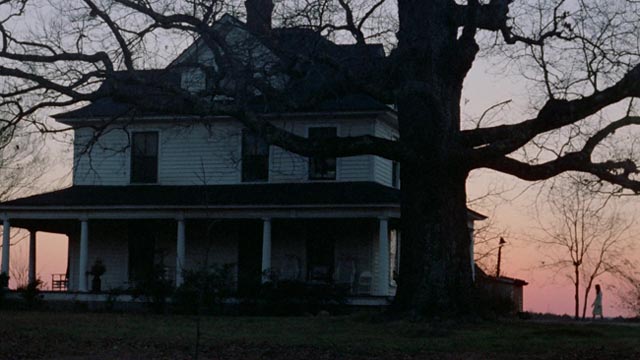
One of the heroes of American Nightmare, Stephen Thrower’s massive survey of American independent horror cinema, is Frederick R. Friedel. The history of Friedel’s brief career in movies and the two features he made back-to-back in the mid ’70s – Axe (1974) and Kidnapped Coed (1975) – is both inspirational and sadly cautionary. An obvious natural talent should have ensured an interesting and successful career, and yet through naivete and inexperience he became entangled with legendary exploitation distributor and notorious crook Harry Novak, who essentially stole both movies, using classic movie business “accounting” to ensure that the filmmaker never saw a penny even though they were widely distributed for years under multiple alternate titles. Friedel didn’t make another movie until 2001’s comedy My Next Funeral. And after that, he made a “fourth” feature by cutting together his first two films into a new hybrid called Bloody Brothers (2003) in an effort to regain possession of his early work.
Born in Brooklyn in 1948, Friedel had no training in film, no experience on a film set, and no idea of what actually was involved in film production. But he did know that Orson Welles had made Citizen Kane when he was twenty-five and decided that he wanted to make a feature by that age himself. So he raised $25,000 (a figure he just pulled out of the air) through his girlfriend’s father’s business connections and moved to Charlotte, North Carolina, because he’d heard there was an active film community there. He connected with J.G. Patterson Jr., a producer, director, sometime actor, and collaborator with Herschell Gordon Lewis. By no means a promising creative partner, Patterson nonetheless had the necessary business skills to help Friedel achieve his aim: taking on the role of producer, he helped Friedel assemble a crew and cast who were more than competent.
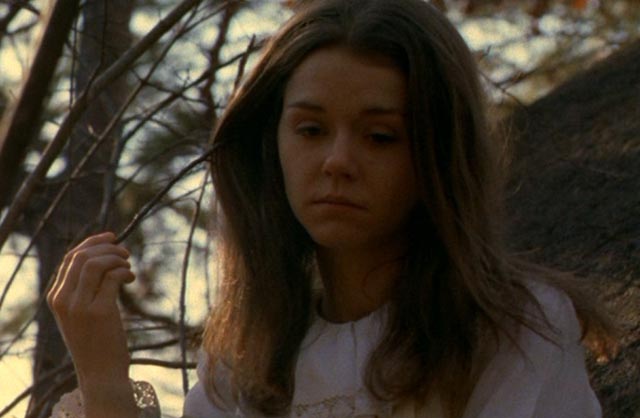
Axe (Frederick R. Friedel, 1974)
Filmed as Lisa, Lisa, and eventually retitled most familiarly as Axe (and less familiarly as California Axe Massacre, The Virgin Slaughter and The Axe Murders), Friedel’s first film tells of three vicious criminals who seek a temporary hideout at a remote farmhouse where a young woman named Lisa lives with her mute, quadriplegic grandfather. What initially looks like a familiar tale of innocents victimized turns out to be something else entirely.
What distinguishes Axe, however, is not the basic exploitation narrative; it’s the way the film is made. While this may in part be attributed to the simple fact that Friedel simply didn’t know how to make a conventional movie, his natural talent transforms what might have been weaknesses into strengths. One of the most distinctive qualities of both Axe and its follow-up, Kidnapped Coed, is the complete absence of character backstories. We know these people only through what we see and hear; we have no way of knowing where their behaviour comes from and this gives both films a mysterious, unsettling quality which works against the often crude directness of many exploitation movies.
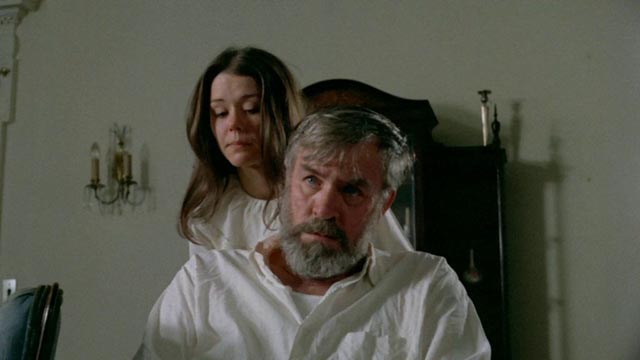
After an evocative, peaceful opening shot of the farmhouse at dusk over which the titles play, the film cuts to a flurry of movement as three men enter a hotel and make their way to a room where they settle down to await someone’s arrival. There’s something threatening about this trio which is established through aggressive body language and small details emphasized by cutaways and quick editing. When the man they’re waiting for arrives – accompanied by another man, with an unstated suggestion of homosexuality – the trio harass the man so violently that they, seemingly inadvertently, beat him to death. In fear, the man’s companion jumps from the window to his death to get away from them.
We have no idea who these three men are, although an obvious hierarchy is quickly established. Steele (Jack Canon) is the cold, psychotic boss; Lomax (Ray Green) is the sadistic sidekick whose unsavoury predilections are authorized by his relationship with Steele; while the younger Billy (Friedel himself) is out of his depth, but for some reason bound to the other two and unable to escape. We don’t know why they were waiting for Aubrey (Frank Jones), what he might have done to inspire their murderous hostility; and this lack of explanation serves to increase the sense of threat they pose to whoever they might subsequently meet.
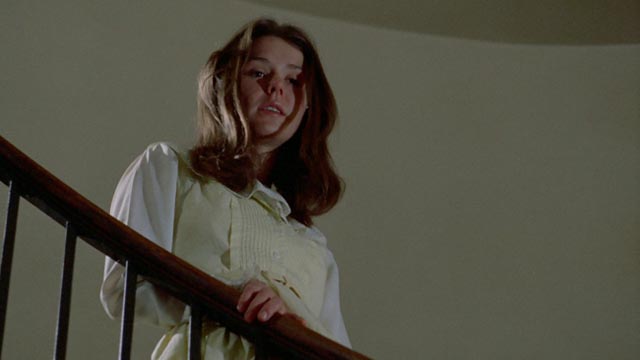
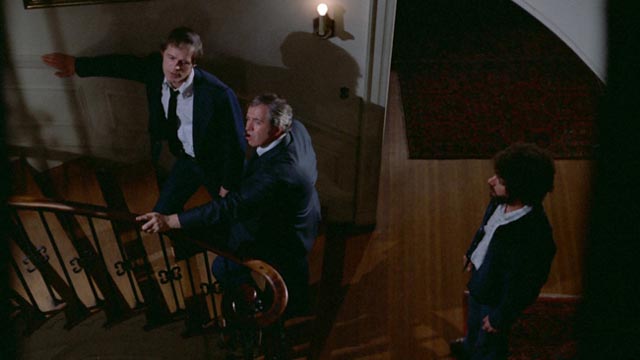
As the three drive out into the country, looking for a place to lay low, their journey is intercut with Lisa’s routines on the farm. She collects eggs from the chickens in the yard – dropping one, she stares at the spilled contents, then scuffs dirt over it. Then she separates one of the hens from the flock and chops its head off with an axe. These actions are all performed with a strange, impenetrable look. Again, with no information provided, a sense of unease is created; Lisa’s apparent lack of affect hints at some kind of trauma. Perhaps this has something to do with her grandfather and the reasons for his silent, paralyzed condition. Or perhaps it’s something else. Is she angry at being trapped here with the old man? Is there an element of aggression, a kind of punishment, in her feeding him raw eggs? And what is behind the repeated emphasis on what may be a fearful stare in the old man’s eyes as he sits motionless in front of a television set whose screen is an indecipherable mess of roiling snow from which the sounds of some game show emerge?
Again, we never learn anything about the history of Lisa (Leslie Lee) and her grandfather (Douglas Powers); and as events gradually unfold, we may come to suspect that perhaps they aren’t actually even related, that their connection may be something much darker. Because after Steele and his men arrive and impose themselves, Lisa’s blankness is revealed as a cover for a violence which is more than a match for the gang’s.
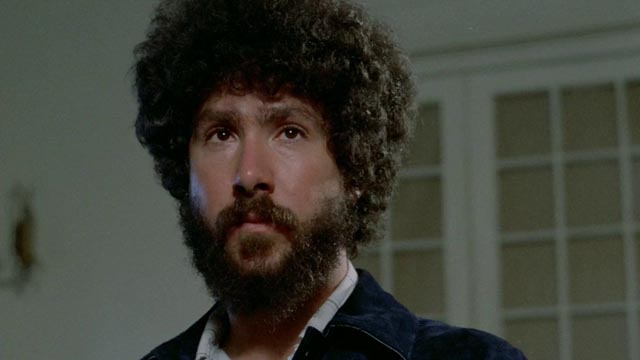
Made the same year as The Texas Chainsaw Massacre, Axe is actually a more artful movie. It’s actually a bit more graphic in its violence, but the obliqueness of Friedel’s style makes it seem less exploitative. Its effect is less overt horror than a subtler, more unsettling psychological disturbance rooted in the feeling that it’s really impossible to know and understand other people fully, that those we meet inevitably conceal depths beneath surface appearances which may well be dark and dangerous.
Despite the very small budget, Axe is far superior to the ordinary run of cheap exploitation movies. The cast is very good, with Leslie Lee in particular giving a very subtle performance in what turned out to be her only appearance on film. Jack Canon has chilling authority as Steele, with fine support from Ray Green and Friedel as his two contrasting henchmen. And Douglas Powers manages to convey with nothing more than his eyes a remarkable sense of someone consumed by some inexpressible fear – a fear unsettlingly focused on Lisa rather than the violent men who have invaded the house. Friedel may have had no previous experience, but his skill in directing the cast is very apparent.
But beyond the performances, the film is very accomplished in its visual technique. Friedel had the great good fortune to get Austin McKinney to shoot the film. McKinney had worked a number of times with Jack Hill and obviously knew how to shoot both quickly and expressively. The film is atmospherically lit, using camera angles and movement to bring out emotional and psychological details. This excellent cinematography combines with the editing (by Friedel in collaboration with producer Patterson) to give the film a visual richness which belies the limited budget. Friedel displays something of the filmmaking skill which characterizes the work of George A. Romero. Like Romero, he constructs scenes through precise, carefully chosen details, rather than simply recording the action, which is all-too-often the easy way out for low budget filmmakers. This approach takes more time and forethought and, in Friedel’s case, is all the more remarkable given that, unlike Romero who had years of editing experience from his work in advertising and industrial films, Friedel had no previous experience. Here, he displays remarkable creative instincts.
*
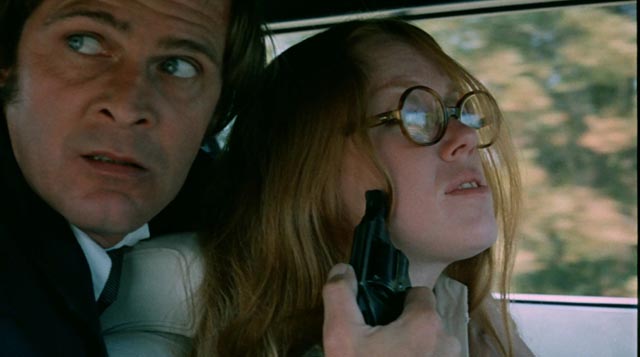
Kidnapped Coed (Frederick R. Friedel, 1975)
Having finished Axe, Friedel immediately set about making a second feature with the same star (Canon) and most of the same crew. The Kidnap Lover (later retitled by Novak Kidnapped Coed … and Date with a Kidnapper) shares many similarities with its predecessor – particularly that absence of backstory which invests the narrative and characters with an air of enigmatic uncertainty. With a bit more money, it was conceived on a larger scale. Essentially a road movie, it uses more locations – again beautifully shot by McKinney – and a larger cast.
Friedel opens the film enigmatically with a tracking shot through an ornate hotel, a banquet room in disarray which hints at some kind of disturbance. Through this walks Sandra Morely (Leslie Ann Rivers), a student. Leaving the hotel, she passes a blind man sitting against the wall begging, walks to her car, gets behind the wheel … and immediately has a gun pressed against the back of her head. Eddie Matlock (Jack Canon) tells her to drive and they set off to wander around the countryside as he makes phone calls to her wealthy father to arrange for the payment of a ransom.
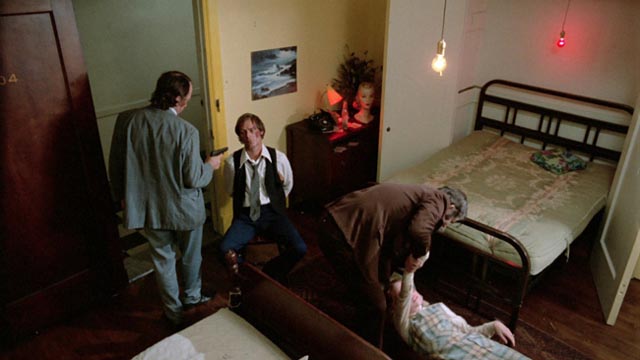
Having established control over Sandra, Eddie even leaves her alone at one point and she doesn’t have the courage to attempt an escape. The tension in this scene – audience frustration at her indecisiveness – suggests something unspoken, which eventually becomes clearer when Sandra later says that she doesn’t actually want to go home to her family. But again, Friedel withholds any explicit explanation of her motives.
This now familiar refusal to offer specific information characterizes the key sequence of the film, when Eddie and Sandra check in to a hotel as they wait for the ransom to be arranged. The desk clerk (Larry Lambeth) seems “off”, sitting and drinking tequila and explaining that today is his last day on the job. There’s no bellboy, because “yesterday was his last day.” After Eddie and Sandra head for their room, the clerk signals to a man sitting in the lobby and the camera pans slightly to reveal what appears to be a dead body lying in the storeroom behind the desk. None of this is explained.
Up in the room, Sandra pretends to go for a shower but instead throws a message written on a toilet roll out of the bathroom window. Some passing kids kick the roll into the gutter, but not long after there’s a knock at the door and when Sandra opens it, the clerk and the other man are standing in the hall. She assumes that they have seen her message and have come to help, but instead they beat Eddie and tie him to a chair, tie Sandra to the bed and rape her. Eddie breaks free and kills the two men.
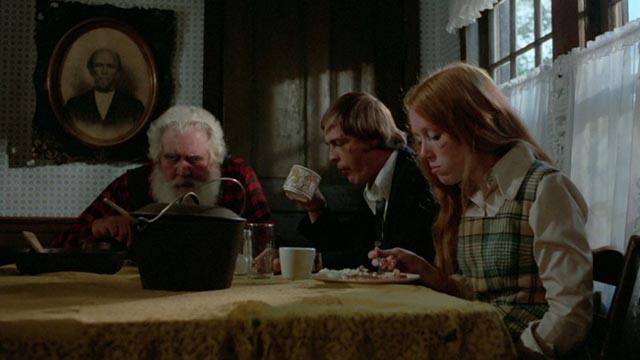
Back on the road, this traumatic event hangs between them and it’s unclear what its lasting impact might be. And yet, an emotional connection gradually grows between girl and kidnapper. At first neither of them seems aware or willing to acknowledge this and the tentative relationship ebbs and flows through subsequent events, which include three more enigmatic encounters. When the car breaks down, Eddie walks to a nearby farm looking for water for the radiator; there he runs into an older man (Clonnie Baxter Strawn) sitting silently on a porch, whose only response to the request for water is to spit on Eddie. Then a younger man (Bob Martin) appears with a shotgun and orders him to get off the property. Here, what superficially looks like a cliche about gun-toting rednecks takes on a mysterious aura; we have no idea why these two men are so hostile to what is really a very simple request, but it adds to the feeling (already forcefully established by the incident in the hotel) that Eddie and Sandra inhabit a dangerous world where no one can be trusted – which in turn begins to inform the bond between them. Despite the fact that he is her kidnapper, they begin to offer an odd kind of security to each other against those outside forces.
This bond is comically reinforced when they’re sheltering in a barn and hear a vehicle pull up outside. Eddie drags Sandra outside and they run into the woods to hide, only to discover that the “threat” is four middle-aged women out on a bird-spotting stroll. But the conflicting tensions between them climax when they arrive at another remote farm, looking for a place to rest. At first they encounter an adolescent girl (Susan McRae) sitting in the dusty yard; she doesn’t respond to Eddie’s questions. Her grandfather (Charles Elledge), a heavyset bearded man, appears and explains that she “hasn’t been the same since she saw her mother die”. He offers them lunch, during which he makes a few probing comments and reveals that he was once the local sheriff. But he offers them a room upstairs to rest until the midday heat lets up.
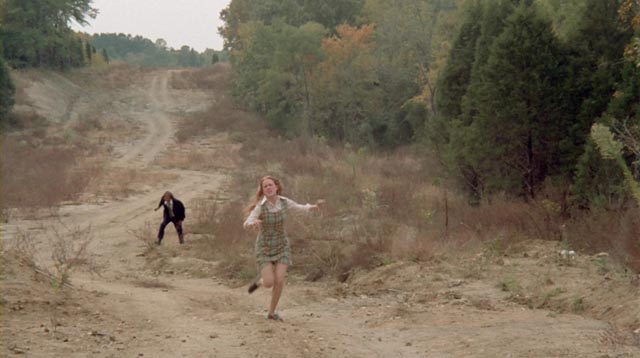
It is in this room that Sandra reveals that she doesn’t want to go home, and she seeks comfort from Eddie. As they make love, the old man sneaks up the stairs with a big kitchen knife in his hand; he spies on them menacingly from the door, but then disappears. Later, as Eddie and Sandra leave the house, the old man attacks them with a pitchfork, leaving Eddie no choice but to shoot him. The shock of seeing this sends Sandra running, muttering over and over again “murderer”, until she reaches a road and sees a man walking ahead of her. Begging him for help, he can do nothing because he’s blind (echoing the blind beggar she ignored outside the hotel at the beginning of the film). When Eddie reaches her, they end up sprawled on the dirt road, clinging to each other.
With no one else for either of them to trust, they finally accept the fact that they’re a couple and prepare to take off with the ransom money which has finally been delivered …
Once again, Friedel takes exploitation elements and works against them; the problematic relationship between kidnapper and victim (fodder for an unsavoury male fantasy) takes on layers of ambiguity which are not neatly simplified with overt explanations of who these characters are and where they have come from. The uncertainty of the film’s world leaves the pair to react to each contingency as best they can, their proximity becoming the basis for a mutually supportive relationship despite the violence with which it began.
*
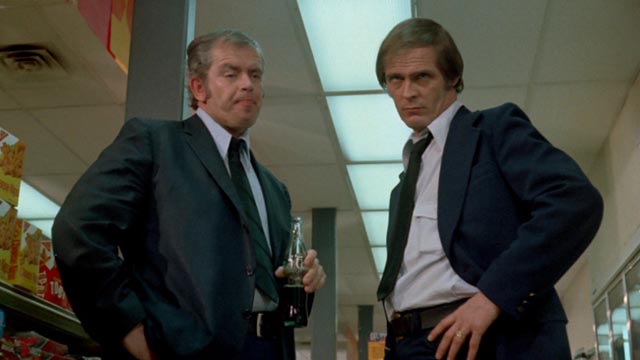
Both these films transcend the genres from which they emerge. Made with subtlety and a sensitivity to character, they reveal a distinctive worldview perhaps more appropriate to existentially-inflected European cinema than low budget American exploitation. There’s genuine art in their making, an unforced visual and thematic poetry. Friedel’s work here is so strong and distinctively individual that it seems obvious he should have gone on to bigger things – if it hadn’t been for his becoming unfortunately tangled with Harry Novak, a circumstance which derailed a career which was getting off to a strong start.
Friedel eventually put these events, and the films, behind him. So it came as a surprise to him to learn decades later that both films had found an enthusiastic audience through various home video releases. (Axe, in fact, had been one of the banned films on Britain’s video nasty list in the ’80s.) When he was invited by Stephen Thrower to a screening in England, he was uneasy, thinking that it might be one of those “bad movie” events where work was shown to be laughed at. Discovering that the audience was genuinely appreciative revived his own interest in this early work and he finally got around to finishing a project he had been toying with since the early ’90s: combining Axe and Kidnapped Coed into a single work built around the fact that Jack Canon starred in both.
In Bloody Brothers, Eddie and Steele are presented as twin orphan brothers separated at birth who coincidentally embark on their crime sprees on the same day thirty-five years later. Friedel is ingenious in intercutting the two strands, gradually drawing the brothers closer and closer together until the two films’ climaxes intersect. Ingenious … but not entirely satisfying because the process inevitably shifts the original films’ focus to concentrate on the two men. This is particularly detrimental to Axe because it diminishes Lisa to a notable degree. Additionally, the compression loses some of the subtle details and careful pacing of the originals. Nonetheless, it’s a fascinating exercise in the possibilities of radically reworking material into new forms.
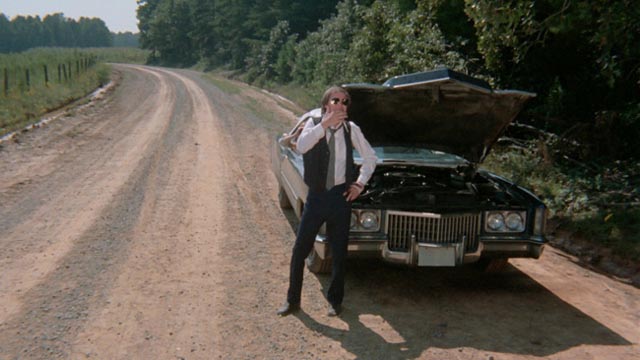
All three films are presented in excellent transfers from the original negatives on Severin’s Blu-ray, which I was a bit slow to catch up with (it was released in 2015). In addition, the disk has substantial supplements which fill in the strange history of their production and subsequent fates. The two original features have commentaries from Friedel, while Stephen Thrower adds a track to Bloody Brothers. Thrower also provides an interview about his own connection with the films and their importance to his book. There’s a one-hour documentary telling the story, with Friedel revisiting Charlotte and meeting key members of the crew again for the first time in years, plus a 38-minute documentary on musicians George Newman Shaw and John Willhelm who provided scores for both films. This proves quite moving as the pair, who were already rising as major figures in the local music scene, were killed in a car crash at age 22, not long after their work on the films. (The release includes a CD of both scores.)
Severin’s release is exemplary, treating these low budget masterpieces with the respect they’re due and providing all the evidence necessary to justify that treatment. After watching everything on this disk, you’ll be angered and offended that circumstances prevented Friedel from making many more movies.
Comments
Bonjour Kenneth
Just watched axe and kidnapped coed,very good especially after reading your blog that I just discovered! keep up writing!
Just a question: do you have a zone free bluray player?
Yes, I’ve been region-free for a long time … I couldn’t survive without it!